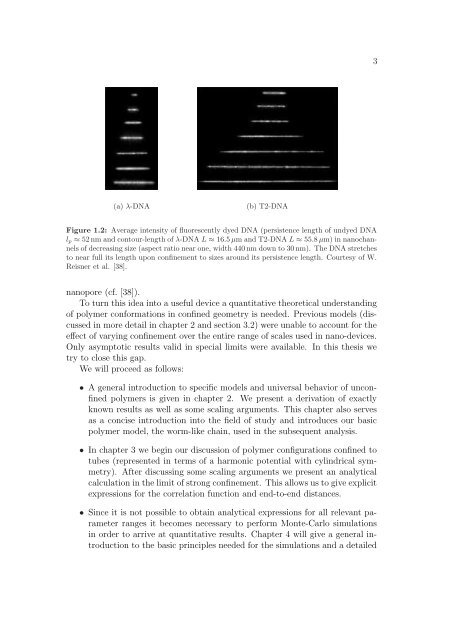Polymers in Confined Geometry.pdf
Polymers in Confined Geometry.pdf
Polymers in Confined Geometry.pdf
Create successful ePaper yourself
Turn your PDF publications into a flip-book with our unique Google optimized e-Paper software.
(a) λ-DNA (b) T2-DNA<br />
Figure 1.2: Average <strong>in</strong>tensity of fluorescently dyed DNA (persistence length of undyed DNA<br />
lp ≈ 52 nm and contour-length of λ-DNA L ≈ 16.5 µm and T2-DNA L ≈ 55.8 µm) <strong>in</strong> nanochannels<br />
of decreas<strong>in</strong>g size (aspect ratio near one, width 440 nm down to 30 nm). The DNA stretches<br />
to near full its length upon conf<strong>in</strong>ement to sizes around its persistence length. Courtesy of W.<br />
Reisner et al. [38].<br />
nanopore (cf. [38]).<br />
To turn this idea <strong>in</strong>to a useful device a quantitative theoretical understand<strong>in</strong>g<br />
of polymer conformations <strong>in</strong> conf<strong>in</strong>ed geometry is needed. Previous models (discussed<br />
<strong>in</strong> more detail <strong>in</strong> chapter 2 and section 3.2) were unable to account for the<br />
effect of vary<strong>in</strong>g conf<strong>in</strong>ement over the entire range of scales used <strong>in</strong> nano-devices.<br />
Only asymptotic results valid <strong>in</strong> special limits were available. In this thesis we<br />
try to close this gap.<br />
We will proceed as follows:<br />
• A general <strong>in</strong>troduction to specific models and universal behavior of unconf<strong>in</strong>ed<br />
polymers is given <strong>in</strong> chapter 2. We present a derivation of exactly<br />
known results as well as some scal<strong>in</strong>g arguments. This chapter also serves<br />
as a concise <strong>in</strong>troduction <strong>in</strong>to the field of study and <strong>in</strong>troduces our basic<br />
polymer model, the worm-like cha<strong>in</strong>, used <strong>in</strong> the subsequent analysis.<br />
• In chapter 3 we beg<strong>in</strong> our discussion of polymer configurations conf<strong>in</strong>ed to<br />
tubes (represented <strong>in</strong> terms of a harmonic potential with cyl<strong>in</strong>drical symmetry).<br />
After discuss<strong>in</strong>g some scal<strong>in</strong>g arguments we present an analytical<br />
calculation <strong>in</strong> the limit of strong conf<strong>in</strong>ement. This allows us to give explicit<br />
expressions for the correlation function and end-to-end distances.<br />
• S<strong>in</strong>ce it is not possible to obta<strong>in</strong> analytical expressions for all relevant parameter<br />
ranges it becomes necessary to perform Monte-Carlo simulations<br />
<strong>in</strong> order to arrive at quantitative results. Chapter 4 will give a general <strong>in</strong>troduction<br />
to the basic pr<strong>in</strong>ciples needed for the simulations and a detailed<br />
3













